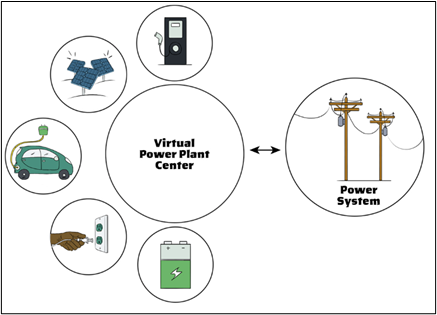How Virtual Power Plants are Transforming Grid Reliability in California
Written by Amardeep Dhanju
November 6, 2025
What is a Virtual Power Plant?
A Virtual Power Plant (VPP), as the name implies, is “virtual” because it is not a single, physical power generation facility. Instead, it is a network of energy resources, such as solar panels, battery storage systems, electric vehicles, smart thermostats and other controllable appliances such as HVAC systems and water heaters. A VPP aggregates and coordinates these systems through advanced software platforms and communications technologies to perform many of the same functions as a conventional power plant. By doing so, a VPP adds energy supply to the statewide electricity grid, reduces energy demand and enhances grid flexibility and reliability.
In simple terms, a VPP functions as a software-driven power plant, using digital coordination among multiple points rather than a single physical generation plant. Its architecture can be understood through three main elements:
Communication: Advanced information technology and communication infrastructure facilitates real-time data exchange between equipment that uses, stores, or generates electricity (these are considered VPP “assets”) and systems that control these assets.
Coordination: Intelligent management of a network of energy resources, including electric appliances, energy storage (e.g., batteries or electric vehicles), and generation (e.g., solar panels) using forecasting, machine learning, and optimization tools.
Supporting grid services: VPPs can participate in markets (regional buying and selling of electricity), provide more consistent supply of electricity to the grid (making the grid more stable), and allow more efficient use of renewable power that is generated intermittently (e.g., solar and wind).
This diagram below shows VPP “assets” on the left. These assets are managed by a single control system that creates the VPP, allowing them to either store electricity from grid, or generate electricity to send to the electric transmission grid.
Source: Marin Clean Energy
In California, a push to expand VPPs is driven by concerns over grid stability – maintaining reliable balance between electricity demand and supply – as the state experiences rapid growth in intermittent renewable generation, especially solar power. State’s ambitious climate and clean energy goals is an equally important driver. Senate Bill 100, enacted in 2018, committed California to achieve 100% clean electricity by 2045, promoting greater interest in technologies that can help balance the state’s generation portfolio. A recent analysis suggests that the state could deploy over 7,500 MW of VPP capacity within the next decade, exceeding the total peak electricity demand of Los Angeles[1]
Examples of VPP systems operating in California are the following:
SunRun CalReady System: This system connects more than 56,000 homes across California to form a large-scale, aggregated power source capable of delivering up to 375 MW to the grid. [2] Participating homeowners receive rewards for supporting the grid during periods of peak demand, by sharing energy stored in their onsite battery systems. The system employs Tesla’s Powerwall 3 battery system, which can be charged from the onsite solar panels or directly from the grid. Recognized as the largest single company VPP in the US, CalReady helps alleviate pressure on California’s power grid during high demand summer months while advancing the state’s transition to renewable energy.
Tesla Virtual Power Plant with Pacific Gas and Electric (PG&E): Through this program, customers with Tesla Powerwall batteries can contribute stored energy to the grid and earn an average of $350 per unit during summer season. This VPP is part of the state Demand Side Grid Support (DSGS) program that provides incentives to support grid during extreme events.
On July 29, 2025, PG&E conducted a statewide test during which the VPP, comprising of Tesla and Sunrun batteries, delivered 535 MW of electricity to the grid over a two-hour period, providing enough power to supply hundreds of thousands of homes during peak demand and demonstrating the value of VPPs in helping prevent grid emergencies. [3]
Are VPPs the same as Microgrids?
VPPs and microgrids serve very different purposes. A microgrid is a localized, physical energy network that includes its own generation sources and can operate independently from the main grid. For example, if the transmission line serving a community is out of service due to a storm, a microgrid can keep power on for the community that it serves. In contrast, a VPP is a digitally coordinated system that is essentially part of the state’s electric grid. A VPP connects and manages distributed energy assets through centralized control, allowing them to function collectively as a flexible power resource for the broader grid.
What are the benefits of creating a VPP?
A VPP offers three significant benefits:
The electrical grid benefits because supply and demand are balanced in real time. As a result, VPPs enhance grid stability by keeping power system steady, improve flexibility by quickly adjusting to changes in demand and supply, and boost reliability by ensuring consistent electricity delivery, while reducing risk of outages. VPPs facilitate the grid’s ability to integrate variable sources of renewable energy like solar and wind, by coordinating storage and flexible loads. VPPs also contribute to peak load management and can reduce the need for new generation or transmission facilities.
Economically, VPPs, enable cost savings for participants through optimized energy use and lower electricity cost, while creating new revenue through time-of-day programs, wholesale markets where electricity is traded, and ancillary services that help maintain grid stability and performance.
Environmentally, VPPs help lower carbon emissions, support grid decarbonization goals, and advance energy democratization by empowering consumers to play an active role in energy markets.
In California, the rapid growth of distributed energy resources, including rooftop solar, battery storage, and electric vehicles, has created new opportunities to aggregate and dispatch small, flexible assets to support the power grid, supported by programs like DSGS.
What challenges are VPPs facing?
VPP deployment faces several challenges. These include the complexity of communication and control systems, cybersecurity and data privacy risks, regulatory and market barriers – such as rules, fees, or participation requirements - that can limit participation. There is also a growing need for interoperability standards, which set common rules and protocols allowing different devices to communicate and work together seamlessly. In addition, achieving consistent performance and fair compensation for participants requires robust policy frameworks and market mechanisms that fully recognize the value of distributed flexibility and grid services.
Conclusion
As the energy landscape continues to evolve, VPPs are emerging as a cornerstone of a more flexible, resilient, and sustainable grid. By intelligently coordinating distributed energy resources, VPPs enable real-time balancing of supply and demand, support renewable energy integration, and empower consumers to actively participate in energy markets. While technical, regulatory, and market challenges remain, ongoing advancements in digitization, AI, policy support, and growing investment is positioning VPPs to play an increasingly vital role in advancing grid reliability, decarbonization, and energy equity in years ahead.
Aspen's expertise in energy infrastructure, distributed energy resources, and the California regulatory processes positions us well to support agencies, utilities, and developers in the planning and implementing of virtual power plants. Reach out to us today to learn more.
[1] Hledik et al., April 2024. California’s Virtual Power potential: How five consumer technologies could improve the state’s energy affordability. A report by Brattle for GridLab.
[2] https://www.sustainability-times.com/energy/56000-homes-become-a-power-plant-california-firm-creates-largest-virtual-energy-source-in-us-with-revolutionary-grid-sharing-tech/
[3] Power of the People: California’s biggest battery test ever just changed the game. August 4, 2025. https://www.pge.com/en/newsroom/currents/future-of-energy/power-to-the-people--california-s-biggest-battery-test-ever-just.html



